
Exhibit 99.01

1 UPDATE Topline Results With TNX - 102 SL In Post - Traumatic Stress Disorder June 2016 Version 0021 6 - 21 - 16 Investor Presentation - June 2016 © 2016 Tonix Pharmaceuticals Holding Corp

2 © 2016 Tonix Pharmaceuticals Holding Corp Cautionary Note on Forward - Looking Statements Certain statements in this presentation regarding strategic plans, expectations and objectives for future operations or results are “forward - looking statements” as defined by the Private Securities Litigation Reform Act of 1995 . These statements may be identified by the use of forward - looking words such as “anticipate,” “believe,” “forecast,” “estimate” and “intend,” among others . These forward - looking statements are based on Tonix’s current expectations and actual results could differ materially . There are a number of factors that could cause actual events to differ materially from those indicated by such forward - looking statements . These factors include, but are not limited to, substantial competition ; our possible need for additional financing ; uncertainties of patent protection and litigation ; uncertainties of government or third party payor reimbursement ; limited research and development efforts and dependence upon third parties ; and risks related to failure to obtain U . S Food and Drug Administration clearances or approvals and noncompliance with its regulations . As with any pharmaceutical under development, there are significant risks in the development, regulatory approval and commercialization of new products . The forward - looking statements in this presentation are made as of the date of this presentation, even if subsequently made available by the Company on its website or otherwise . Tonix does not undertake an obligation to update or revise any forward - looking statement, except as required by law . Investors should read the risk factors set forth in the Annual Report on Form 10 - K for the year ended December 31 , 2015 , as filed with the Securities and Exchange Commission (the “SEC”) on March 3 , 2016 , and future periodic reports filed with the SEC on or after the date hereof . All of the Company's forward - looking statements are expressly qualified by all such risk factors and other cautionary statements .

3 © 2016 Tonix Pharmaceuticals Holding Corp Investment Thesis for Tonix Pharmaceuticals UPDATE Differentiated Late - Stage Program Commercially Attractive Markets • TNX - 102 SL (cyclobenzaprine sublingual tablets), 2.8 mg • Differentiated with unique attributes that address unmet needs of target markets • Clinically validated in fibromyalgia (FM) • Completed: Phase 2; demonstrated relief from chronic wide - spread pain • Enrollment in Phase 3 FM completed with topline results expected 3Q 2016 • Positive topline results in Phase 2 - post - traumatic stress disorder (PTSD) • Target indications, FM and PTSD, are common chronic disorders • Underserved markets with high levels of dissatisfaction • A differentiated product has potential to capture substantial share TNX - 102 SL (cyclobenzaprine HCl sublingual tablets), 2.8 mg is an Investigational New Drug and is not approved for any indication. © 2016 Tonix Pharmaceuticals Holding Corp

4 © 2016 Tonix Pharmaceuticals Holding Corp Therapeutic Approach Used to Develop TNX - 102 SL Sleep quality: • How refreshing or satisfying was his or her sleep? • Emotional , mental, and physical rejuvenation to feel well and focused • Not always correlated with sleep quantity ( ~ insomnia/sedative hypnotics) Pursuing what is most important to patients and their physicians… Reduce burden of disease ( therapeutic benefit ) … With a Unique Approach Achieve therapeutic benefit by improving sleep quality

5 © 2016 Tonix Pharmaceuticals Holding Corp Relevance of Sleep Disturbances for FM and PTSD Sleep disturbances: x C ore symptoms of FM and PTSD • Disturbances may be qualitatively different x Believed to have a role in the pathophysiology of both disorders om Sleep As a Core Symptom P athophysiology Therapeutic Benefit 1 o Clinical Endpoint Pharmacological Action 2 o Clinical Endpoint FM x Unrefreshing sleep CNS processing of sensory input • 'Central - sensitization' or a mplification of pain signals associated with disturbed sleep Relief of chronic widespread pain Relief from sleep disturbances PTSD x Nightmares x Hyperarousal Stress ≈ Hyperarousal ≈ Sleep Disturbances • Hyperarousal and hypervigilance interfere with sleep Reduce PTSD symptoms Relief from sleep disturbances Reduce hyperarousal CNS = central nervous system

6 © 2016 Tonix Pharmaceuticals Holding Corp CBP targets receptors with potential therapeutic effects for sleep disturbances • Multimodal: high affinity, relative selectivity and functional antagonism • 5 - HT 2A • a 1 - adrenergic • histamine H 1 • 6 - 7 fold lower affinity for SERT and NET (serotonin and norepinephrine transporters) • Profile differs from active metabolite norcyclobenzaprine, amitriptyline and other tricyclics Cyclobenzaprine: Potential t o Improve Sleep Quality Cyclobenzaprine (CBP) is structurally a tricyclic molecule Tricyclics and their metabolites differ significantly in their receptor binding profiles

7 © 2016 Tonix Pharmaceuticals Holding Corp Designed to take advantage of targeted high affinity receptors of CBP Differentiated from immediate release oral CBP : • Formulated for transmucosal absorption to allow sublingual administration at bedtime • Rapid systemic exposure • Improved bioavailability • Avoids first - pass metabolism, reducing formation of norcyclobenzaprine (nCBP) • Half - life (t 1/2 ) of 72 hours • Distinct receptor binding profile less selective for target receptors • Potential undesirable off - target functional activities TNX - 102 SL: Innovative and Differentiated TNX - 102 SL: A low - dose sublingual formulation of CBP

8 © 2016 Tonix Pharmaceuticals Holding Corp TNX - 102 SL : Novel, Proprietary Formulation API Cyclobenzaprine HCl Route of Administration Sublingual - rapid absorption - avoids first - pass metabolism Formulation Protectic TM - protective eutectic formulation - intellectual property rights - stability for transmucosal formulation Dose 2.8 mg tablet - very low dose Dosing At bedtime - once daily Key Product Features :

9 © 2016 Tonix Pharmaceuticals Holding Corp TNX - 102 SL 2.8 mg PK Profile relative to 5 mg oral IR CBP: 0 500 1000 1500 2000 2500 3000 3500 4000 0 4 8 12 16 20 24 Concentration (ng/mL) TNX - 102 SL 2.8 mg Oral IR CBP 5 mg x More prominent from hours 8 - 24 ('daytime') x Reduced exposure to nCBP by 48 % • Anticipate at steady - state: • Equally present day and night • Less accumulation relative to oral IR CBP TNX - 102 SL: Results from Single - Dose PK Study 0 200 400 600 800 1000 1200 1400 1600 0 4 8 12 16 20 24 Oral IR CBP 5 mg TNX - 102 SL 2.8 mg Hours Hours nCBP: x Rapid absorption for bedtime dosing x Peak concentration (C max ) reduced by 20% x Maintains desired nighttime characteristics • Peak concentration ( t max ) occurs at ~4 hours • ~50% of exposure occurs during the first 8 hours CBP: Tonix Study F104

10 © 2016 Tonix Pharmaceuticals Holding Corp Intellectual P roperty Portfolio of international patents filed under the Patent Cooperation Treaty (PCT ) C omposition - of - matter (eutectic) • Patents filed • Protection expected to 2034 Pharmacokinetics (PK) • Patents filed • Protection expected to 2033 Method - of - use • Fibromyalgia: patents issued, 2020 expiry • PTSD: patents filed TNX - 102 SL Fibromyalgia , PTSD

11 © 2016 Tonix Pharmaceuticals Holding Corp BestFit Study - TNX - 102 SL Phase 2 in Fibromyalgia Placebo once - daily at bedtime 12 weeks TNX - 102 SL once - daily at bedtime N = 102 N = 103 2.8 mg open - label extension 1. FDA - accepted primary endpoint in current Phase 3 AFFIRM study • Randomized, double - blind, placebo - controlled study in fibromyalgia • N=205 randomized from 17 U.S. sites • Efficacy endpoint: • Pre - specified primary endpoint: change in week 12 mean pain score (p=0.17) • Difference in 30% pain responder analysis at week 12 between TNX - 102 SL and placebo • Other efficacy endpoints: • Fibromyalgia Impact Questionnaire - Revised ( FIQ - R ) • Patient Global Impression of Change • PROMIS Sleep Disturbance

12 © 2016 Tonix Pharmaceuticals Holding Corp BestFit Key Clinical Results 20.6% 34.0% 0% 10% 20% 30% 40% Pain Relief 30 % Responder Rate Based on Pain NRS Placebo n=102 TNX - 102 SL n=103 P =.033 Logistic regression NRS=Numeric Rating Scale Placebo n =85 TNX - 102 SL n=89 P =.005 - 5.1 - 9.0 -10 -8 -6 -4 -2 0 Reduction in Sleep Disturbances PROMIS Sleep T - Score (MMRM) MMRM=Mixed model for repeated measures FIQ - R=Fibromyalgia Impact Questionnaire - Revised Placebo n =84 TNX - 102 SL n=89 P =. 014 - 8.5 - 15.6 -20 -15 -10 -5 0 Reduction in Disease Burden FIQ - R Total Score (MMRM) Response at Week 12 MMRM=Mixed model for repeated measures

13 © 2016 Tonix Pharmaceuticals Holding Corp BestFit Safety and Tolerability Profile No serious adverse events (SAE) reported with TNX - 102 SL Systemic adverse events reported by at least 3.0% of the total BESTFIT study population: Most frequent local adverse events were administration site reactions • Transient tongue numbness (44% TNX - 102 SL vs. 2% placebo) • Abnormal taste (8% TNX - 102 SL vs. 0% placebo) 6.9% 4.0% 3.0% 2.0% 3.0% 1.9% 3.9% 4.9% 4.9% 3.9% 4.4% 3.9% 3.9% 3.4% 3.4% 0.00% 2.00% 4.00% 6.00% 8.00% Somnolence Dry Mouth Back Pain Nausea Sinusitis Placebo (n=101) TNX-102 SL (n=103) Total (n=204)

14 © 2016 Tonix Pharmaceuticals Holding Corp FULLY ENROLLED - Topline Expected 3Q 2016 • Second Phase 3 Study (“REAFFIRM”) expected to begin in July 2016 - Expected to be similar to AFFIRM in design and sample size AFFIRM Study - TNX - 102 SL Phase 3 in Fibromyalgia • Randomized, double - blind, placebo - controlled study in fibromyalgia • N=519 ; 35 U.S. clinical sites • Primary efficacy endpoint: • Difference in 30% pain responder analysis at Week 12 between TNX - 102 SL and placebo Placebo once - daily at bedtime 12 weeks TNX - 102 SL once - daily at bedtime N ≈ 259 N ≈ 259 2.8 mg open - label extension

15 © 2016 Tonix Pharmaceuticals Holding Corp Targeting Military - related PTSD 15 1. Friedman et al., 2007, 2. Zoloft Package Insert, August, 2014, 3. Paxil Package Insert, June, 2014 Military - related PTSD not well - served by existing FDA - approved therapies • No treatment response observed in U.S. military populatio n Sertraline: negative in large multicenter trial in U.S. military (placebo numerically better) 1 Paroxetine: not studied in military population • Inconsistent treatment response observed in males Sertraline: FDA conducted post - hoc analysis concluded no effect for male civilian subgroup 2 Paroxetine: no sex - related difference in treatment outcomes 3 • Important tolerability issues with SSRIs in this population Sexual dysfunction Insomnia © 2016 Tonix Pharmaceuticals Holding Corp

16 © 2016 Tonix Pharmaceuticals Holding Corp AtEase Study - TNX - 102 SL Phase 2 in PTSD • Randomized, double - blind, placebo - controlled trial in military - related PTSD • N=231 ; 24 U.S. clinical sites • Primary efficacy endpoint: D ifference in Clinician - Administered PTSD Scale ( CAPS - 5 ) score between TNX - 102 SL 2.8 mg and placebo at week 12 Placebo at bedtime once - daily 12 weeks N = 92 TNX - 102 SL at bedtime once - daily N = 90 2.8 mg open - label extension 0 mg TNX - 102 SL at bedtime once - daily N = 49 5.6 mg

17 © 2016 Tonix Pharmaceuticals Holding Corp AtEase Study Key Demographics / Characteristics of AtEase • 93% of the sample was male • 98% had trauma during military service and were deployed on average 2.3 times • Mean time since index trauma was 7 years • Race and ethnicity generally consistent with U.S. military distribution • Similar baseline CAPS - 5 scores and MADRS scores across treatment arms • Average CAPS - 5 scores were greater than 39 for all groups ('severe' PTSD*) *personal communication – Frank Weathers PhD, National Center for PTSD © 2016 Tonix Pharmaceuticals Holding Corp
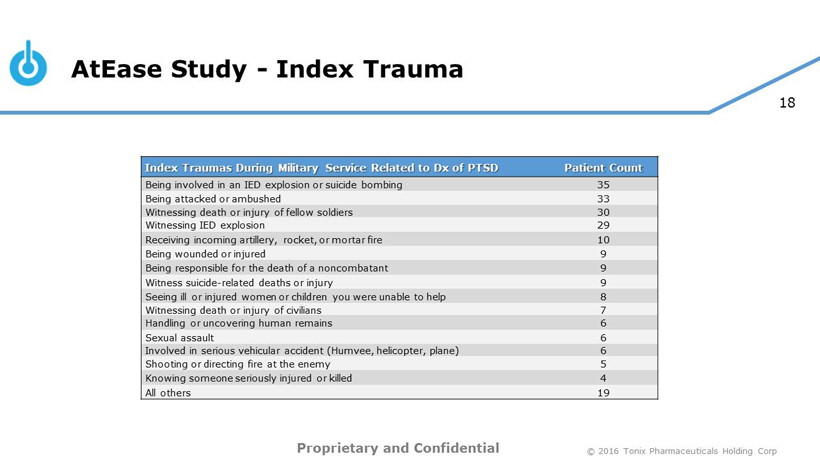
18 AtEase Study - Index Trauma Proprietary and Confidential © 2016 Tonix Pharmaceuticals Holding Corp Index Traumas During Military Service Related to Dx of PTSD Patient Count Being involved in an IED explosion or suicide bombing 35 Being attacked or ambushed 33 Witnessing death or injury of fellow soldiers 30 Witnessing IED explosion 29 Receiving incoming artillery, rocket, or mortar fire 10 Being wounded or injured 9 Being responsible for the death of a noncombatant 9 Witness suicide - related deaths or injury 9 Seeing ill or injured women or children you were unable to help 8 Witnessing death or injury of civilians 7 Handling or uncovering human remains 6 Sexual assault 6 Involved in serious vehicular accident (Humvee, helicopter, plane) 6 Shooting or directing fire at the enemy 5 Knowing someone seriously injured or killed 4 All others 19
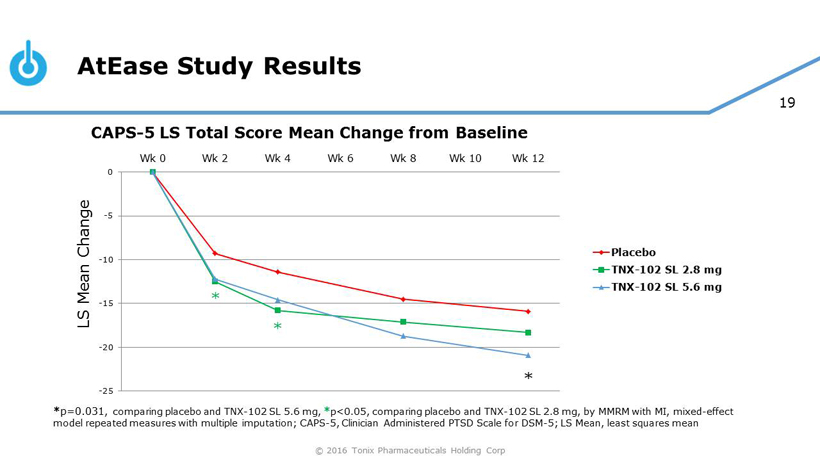
19 © 2016 Tonix Pharmaceuticals Holding Corp AtEase Study Results -25 -20 -15 -10 -5 0 Wk 0 Wk 2 Wk 4 Wk 6 Wk 8 Wk 10 Wk 12 Placebo TNX-102 SL 2.8 mg TNX-102 SL 5.6 mg * * p=0.031 , comparing placebo and TNX - 102 SL 5.6 mg, * p<0.05, comparing placebo and TNX - 102 SL 2.8 mg, by MMRM with MI, mixed - effect model repeated measures with multiple imputation; CAPS - 5 , Clinician Administered PTSD Scale for DSM - 5; LS Mean, least squares mean LS Mean Change * * CAPS - 5 LS Total Score Mean Change from Baseline

20 © 2016 Tonix Pharmaceuticals Holding Corp AtEase Study Results -7 -6 -5 -4 -3 -2 -1 0 Wk 0 Wk 2 Wk 4 Wk 6 Wk 8 Wk 10 Wk 12 Placebo TNX-102 SL 2.8 mg TNX-102 SL 5.6 mg * * * * * * LS Mean Change * p<0.05, comparing TNX - 102 SL 5.6 mg to placebo, mixed - effect model repeated measures * p<0.05, comparing TNX - 102 SL 2.8 mg to placebo, mixed - effect model repeated measures CAPS - 5 Arousal and Reactivity Cluster Score Mean Change

21 © 2016 Tonix Pharmaceuticals Holding Corp AtEase Study Results 44.6% 53.3% 63.3% 0% 10% 20% 30% 40% 50% 60% 70% Placebo TNX-102 SL 2.8 mg TNX-102 SL 5.6 mg * *p=0.041 , Logistic regression comparing placebo and TNX - 102 SL 5.6 mg Responders are those rated as “much improved” or “very much improved” Clinician Global Impression – Improvement Scale Responders

22 © 2016 Tonix Pharmaceuticals Holding Corp AtEase Study Results Sheehan Disability Scale – Work/School & Social/Leisure Domains 1.5 2 2.5 3 3.5 4 4.5 5 5.5 Wk 0 Wk 2 Wk 4 Wk 6 Wk 8 Wk 10 Wk 12 Placebo TNX-102 SL 2.8 mg TNX-102 SL 5.6 mg 2.5 3 3.5 4 4.5 5 5.5 6 6.5 7 7.5 Wk 0 Wk 2 Wk 4 Wk 6 Wk 8 Wk 10 Wk 12 Placebo TNX-102 SL 2.8 mg TNX-102 SL 5.6 mg The symptoms have disrupted your work/school work The symptoms have disrupted your social/leisure activities * * * * *p≤0.05, TNX - 102 SL 5.6 mg v. Placebo, MMRM, MMRM, mixed - effects model repeated measure *p<0.05, TNX - 102 SL 5.6 mg v. Placebo, MMRM

23 © 2016 Tonix Pharmaceuticals Holding Corp AtEase Study Results Adverse Events (≥5% rate in any group) Preferred Term Placebo N=94* TNX - 102 SL 2.8 mg N=93* TNX - 102 SL 5.6 mg N=50* Overall N=237* Local Administration Site Conditions Hypoaesthesia oral 2 ( 2.1%) 36 (38.7%) 18 (36.0%) 54 (37.8%) Paraesthesia oral 3 ( 3.2%) 15 (16.1%) 2 ( 4.0%) 17 (11.9%) Glossodynia 1 ( 1.1%) 3 ( 3.2%) 3 ( 6.0%) 6 ( 4.2%) Systemic Adverse Events Somnolence 6 ( 6.4%) 11 (11.8%) 8 (16.0%) 19 (13.3%) Dry mouth 10 (10.6%) 4 ( 4.3%) 8 (16.0%) 12 ( 8.4%) Headache 4 ( 4.3%) 5 ( 5.4%) 6 (12.0%) 11 ( 7.7%) Insomnia 8 ( 8.5%) 7 ( 7.5%) 3 ( 6.0%) 10 ( 7.0%) Sedation 1 ( 1.1%) 2 ( 2.2%) 6 (12.0%) 8 ( 5.6%) Upper respiratory tract infection 5 ( 5.3%) 3 ( 3.2%) 2 ( 4.0%) 5 ( 3.5%) Abnormal dreams 5 ( 5.3%) 1 ( 1.1%) 1 ( 2.0%) 2 ( 1.4%) Weight increased 5 ( 5.3%) 1 ( 1.1%) 1 ( 2.0%) 2 ( 1.4%) Completer Rate: Placebo 73% TNX - 102 SL 2.8 mg 79% TNX - 102 SL 5.6 mg 84%

24 © 2016 Tonix Pharmaceuticals Holding Corp AtEase Study Summary of Results Presented at American Society of Clinical Psychopharmacology, May 31, 2016 • Recruited a population with severe military - related PTSD , almost exclusively combat traumas incurred during OIF/OEF/OND deployments: • Predominantly male • TNX - 102 SL at 5.6 mg daily at bedtime for 12 weeks: • Reduced severity of PTSD (CAPS - 5, p=0.031, Effect Size=0.39) • Reduced key symptoms (hyperarousal, insomnia, startle) • Improved global symptoms (CGI - I) and function (SDS work/school and social/leisure) • Tolerability evidenced by retention rate (84%) and low systemic side effects with only one discontinuation for AE (increased nightmares ) • TNX - 102 SL at 2.8 mg daily at bedtime for 12 weeks: • Reduced PTSD symptoms (CAPS - 5) at weeks 2 and 4 • Reduced hyperarousal at weeks 2, 4 and 8 • Non - significant intermediate effects at week 12 on PTSD symptoms, global and functional improvement (CAPS - 5 total, sleep and startle items, CGI - I, SDS) OIF/OEF/OND, Operation Iraqi Freedom/Operation Enduring Freedom/Operation New Dawn CGI - I, Clinician Global Impression – Improvement scale; CAPS - 5, Clinician Administered PTSD Scale for DSM - 5; SDS, Sheehan Disability Scale
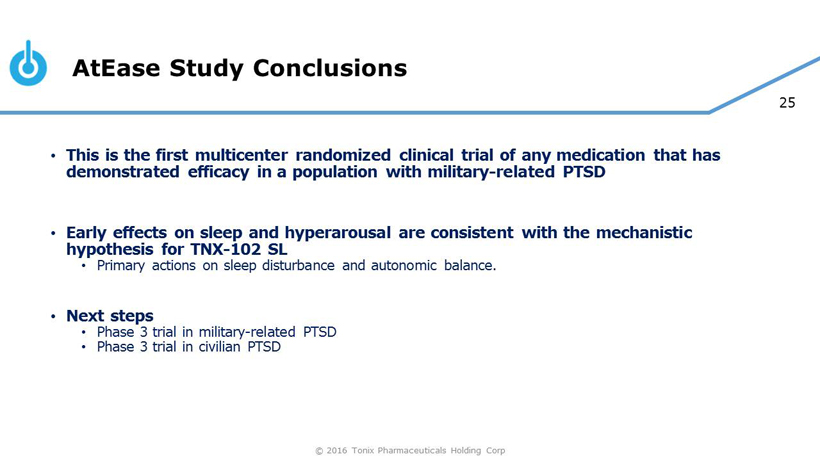
25 © 2016 Tonix Pharmaceuticals Holding Corp AtEase Study Conclusions • This is the first multicenter randomized clinical trial of any medication that has demonstrated efficacy in a population with military - related PTSD • Early effects on sleep and hyperarousal are consistent with the mechanistic hypothesis for TNX - 102 SL • P rimary actions on sleep disturbance and autonomic balance. • Next steps • Phase 3 trial in military - related PTSD • Phase 3 trial in civilian PTSD
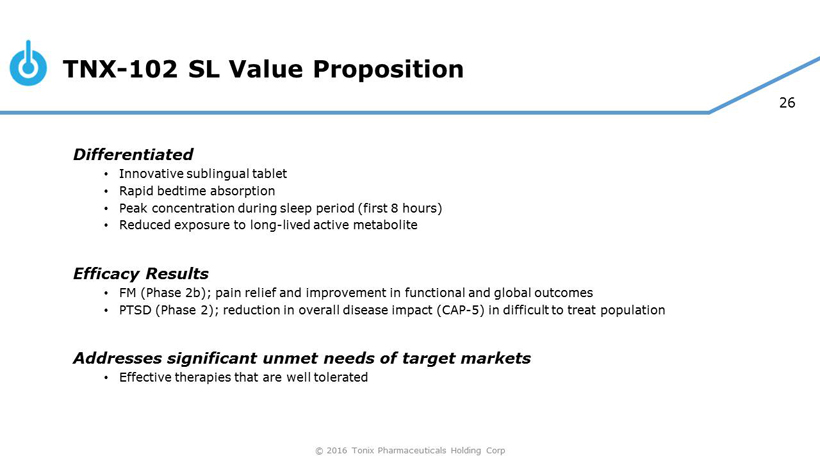
26 © 2016 Tonix Pharmaceuticals Holding Corp TNX - 102 SL Value Proposition Differentiated • Innovative sublingual tablet • Rapid bedtime absorption • Peak concentration during sleep period (first 8 hours) • Reduced exposure to long - lived active metabolite Efficacy Results • FM (Phase 2b); pain relief and improvement in functional and global outcomes • PTSD (Phase 2); reduction in overall disease impact (CAP - 5) in difficult to treat population Addresses significant unmet needs of target markets • Effective therapies that are well tolerated
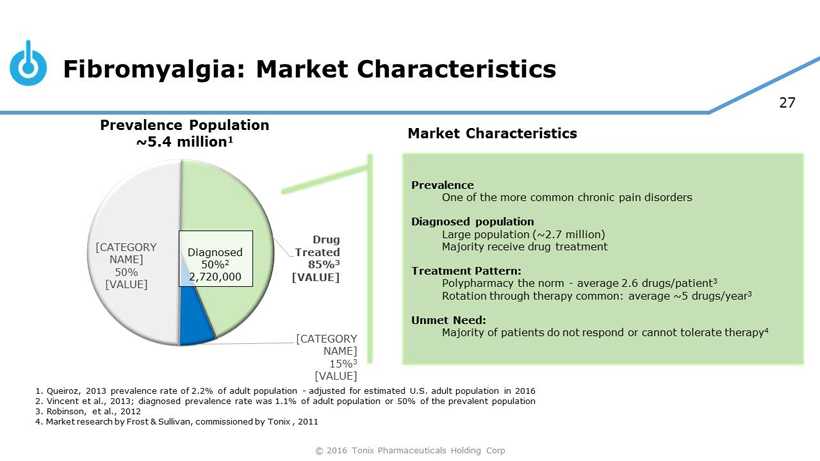
27 © 2016 Tonix Pharmaceuticals Holding Corp Fibromyalgia: Market Characteristics [CATEGORY NAME] 50% [VALUE] Drug Treated 85% 3 [VALUE] [CATEGORY NAME] 15% 3 [VALUE] Prevalence Population ~5.4 million 1 1. Queiroz , 2013 prevalence rate of 2.2% of adult population - adjusted for estimated U.S. adult population in 2016 2. Vincent et al., 2013; diagnosed prevalence rate was 1.1% of adult population or 50% of the prevalent population 3. Robinson, et al., 2012 4. Market research by Frost & Sullivan, commissioned by Tonix , 2011 Diagnosed 50% 2 2,720,000 Market Characteristics Prevalence One of the more common chronic pain disorders Diagnosed population Large population (~ 2.7 million) Majority receive drug treatment Treatment Pattern: Polypharmacy the norm - average 2.6 drugs/patient 3 Rotation through therapy common: average ~5 drugs/year 3 Unmet Need: Majority of patients do not respond or cannot tolerate therapy 4
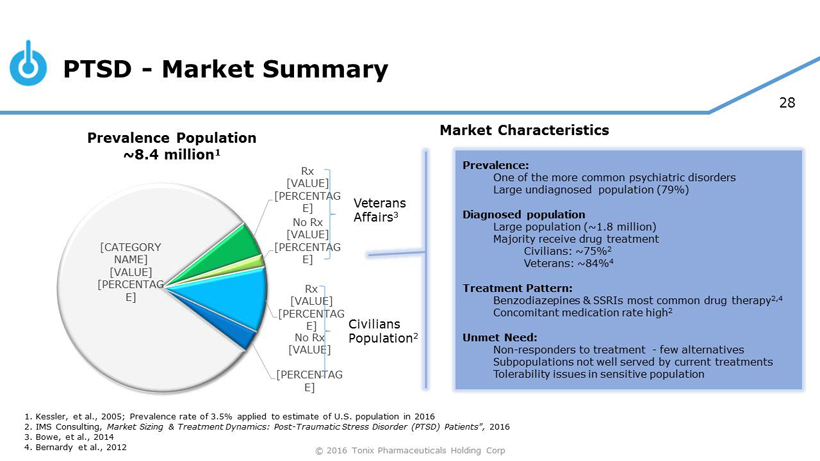
28 © 2016 Tonix Pharmaceuticals Holding Corp PTSD - Market Summary [CATEGORY NAME] [VALUE] [PERCENTAG E] Rx [VALUE] [PERCENTAG E] No Rx [VALUE] [PERCENTAG E] Rx [VALUE] [PERCENTAG E] No Rx [VALUE] [PERCENTAG E] Prevalence Population ~8.4 million 1 1. Kessler, et al., 2005; Prevalence rate of 3.5% applied to estimate of U.S. population in 2016 2. IMS Consulting, Market Sizing & Treatment Dynamics : Post - Traumatic Stress Disorder (PTSD) Patients", 2016 3. Bowe, et al., 2014 4. Bernardy et al., 2012 Veterans Affairs 3 Civilians Population 2 Prevalence: One of the more common psychiatric disorders Large undiagnosed population (79%) Diagnosed population Large population (~1.8 million) Majority receive drug treatment Civilians: ~75% 2 Veterans: ~84% 4 Treatment Pattern: Benzodiazepines & SSRIs most common drug therapy 2,4 Concomitant medication rate high 2 Unmet Need: Non - responders to treatment - few alternatives Subpopulations not well served by current treatments Tolerability issues in sensitive population Market Characteristics
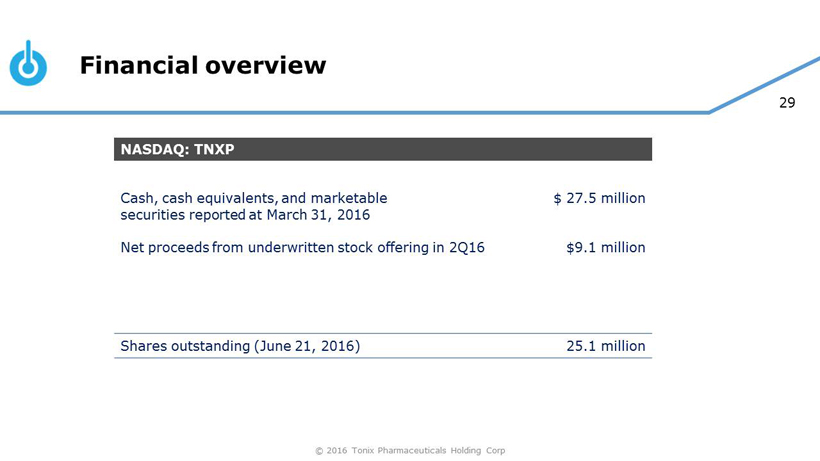
29 © 2016 Tonix Pharmaceuticals Holding Corp Financial overview NASDAQ: TNXP Cash, cash equivalents, and marketable securities reported at March 31, 2016 Net proceeds from underwritten stock offering in 2Q16 $ 27.5 million $9.1 million Shares outstanding (June 21, 2016) 25.1 million
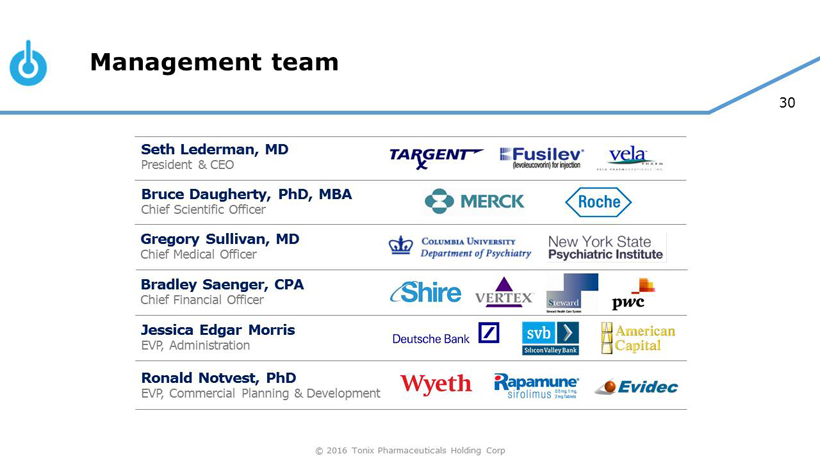
30 © 2016 Tonix Pharmaceuticals Holding Corp Management team Seth Lederman, MD President & CEO Jessica Edgar Morris EVP, Administration Bruce Daugherty, PhD, MBA Chief Scientific Officer Ronald Notvest, PhD EVP, Commercial Planning & Development Gregory Sullivan, MD Chief Medical Officer Bradley Saenger, CPA Chief Financial Officer
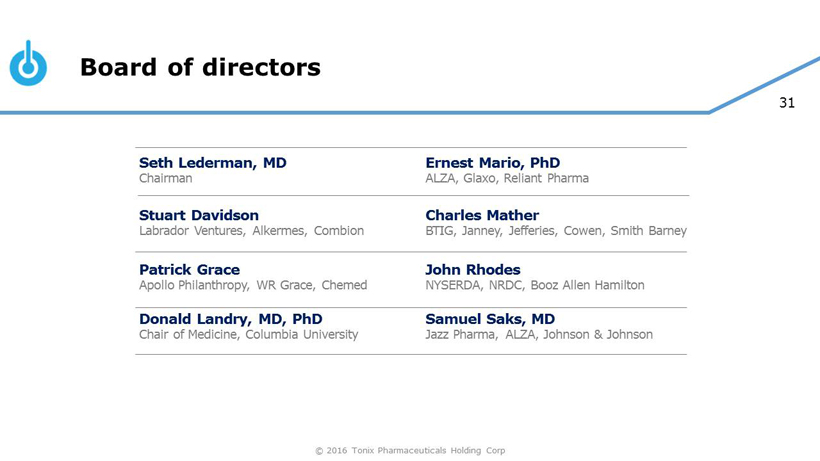
31 © 2016 Tonix Pharmaceuticals Holding Corp Board of directors Seth Lederman, MD Chairman Ernest Mario, PhD ALZA, Glaxo, Reliant Pharma John Rhodes NYSERDA, NRDC, Booz Allen Hamilton Samuel Saks, MD Jazz Pharma, ALZA, Johnson & Johnson Charles Mather BTIG, Janney, Jefferies, Cowen, Smith Barney Stuart Davidson Labrador Ventures, Alkermes , Combion Patrick Grace Apollo Philanthropy, WR Grace, Chemed Donald Landry, MD, PhD Chair of Medicine, Columbia University
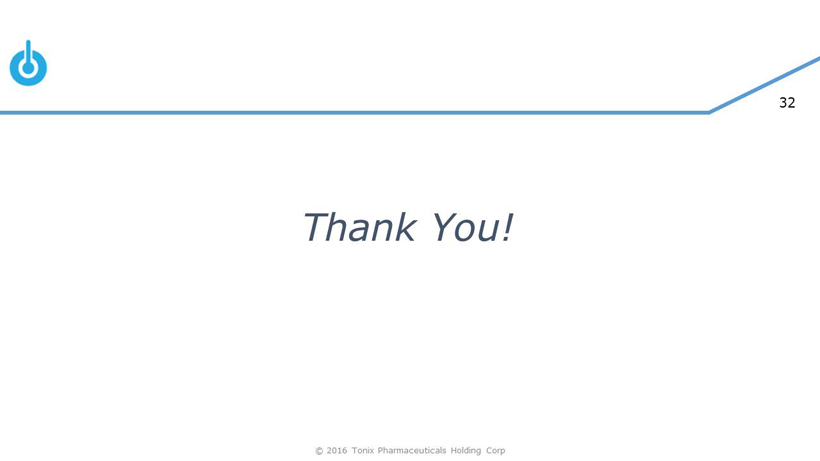
32 © 2016 Tonix Pharmaceuticals Holding Corp Thank You!